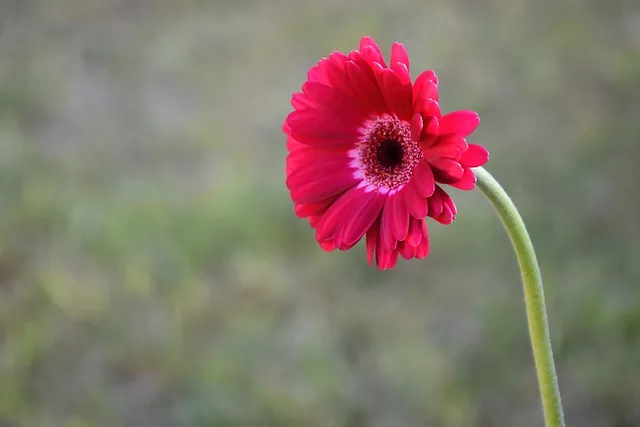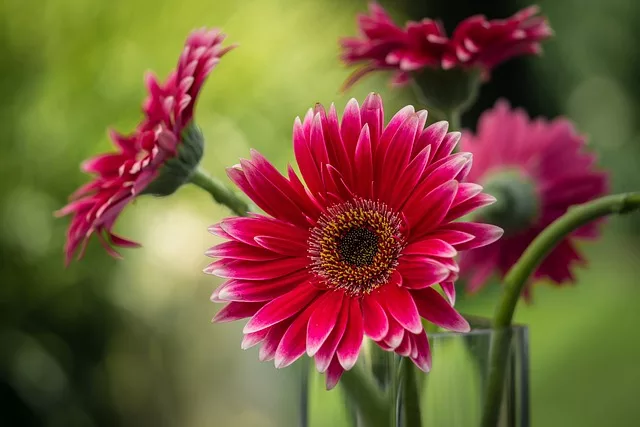The Gerbera can be propagated through seeds, cuttings, or by division of the rhizome. In this blog, we will talk about how to grow gerbera from cuttings and also touch a bit about the other methods.
How to grow gerbera from cuttings

Step 1. Preparation
Before taking gerbera cuttings prepare the site where you will place the cuttings after cropping from the plant. The area or containers should be ready to root the cuttings, so you don’t risk drying them out while they wait. The plants themselves must also be in peak condition to provide healthy cuttings, they should not be under stress.
Step 2. Collect and prepare the gerbera cuttings
The best time to collect gerbera cuttings is when they are actively growing in the summer. Choose a healthy plant and take 6-inch sections for optimal rooting. However, do not forget to prepare the cuttings before planting.
As with other plant cuttings, you’ll want to remove the leaves at the bottom, as they can lead to rot when they come in contact with the soil. It would be best if you also got rid of the flowers on your cuttings to help them focus on root development.
Step 3. Planting and maintenance when propagating gerberas from cuttings
After preparing the cuttings you could encourage a faster rooting by soaking the cuttings in a hormone rooting mix for about 2 hours. This mix you can buy this at your local store.
After soaking a preparing the cuttings go ahead and water the soil. In addition to misting the soil, you can even create a humid environment by placing the containers in the greenhouse. Cover each pot with a plastic bag to help conserve moisture, then place them in the greenhouse to maintain favorable conditions. if you don’t have a greenhouse, don’t worry, just select an area that is bright but does not receive direct sunlight this will help the cuttings grow.
After 5/8 days you can gently pull on the cuttings to check for roots. Make sure you keep the soil moist. If the soil dries up this could be fatal for the propagation.
After 15/20 days you should see healthy roots coming from your cuttings, after this you can proceed to transplant the gerbera.
So that pretty much answers the question of how to grow gerbera from cuttings. At first glance, it could be hard to understand, but I assure you is easier than it looks.
Planting gerberas
Location
Grow them in a location with well-draining soil and full sun to encourage healthy flowering. Is a good practice to test your soil to check the pH level and if you need to make amendments to its nutrients and structure.
Caring and common problems.
Gerberas do best if you feed them well. You can add a balanced fertilizer to the bed and provide fertilizer at each watering. You should also check the soil if it gets too dry to prevent the gerberas from wilting, but watch out for root rot if the soil is too wet.
Another thing to remember to avoid disease is the optimal spacing for good air circulation between your plants. You can also water early in the morning, so they don’t have wet foliage at night.
In general, gerberas do not face many problems. Proper maintenance and consistent environmental conditions should keep fungal infestations or diseases at bay. However, keep an eye out for aphids to tackle them quickly.
How to prune gerberas
Another maintenance practice to remember when growing gerberas is pruning. This will help the plant look neat and well cared, for while also producing healthy blooms. Watch for faded flowers during the growing season and remove them before the petals drop.
Cut where the stems emerge from the leaves to prevent seed development. You can also trim or pinch back unhealthy-looking leaves during the season to create better foliage. Heading and trimming both aim not only for aesthetic value but also to help the plant grow back into healthier parts.
Lastly, you will want to cut the gerberas before the first frost. Cut them to an inch tall and transfer them to the greenhouse for protection. If you are in a warmer location, you can simply mulch the plants and overwinter outdoors.

Other propagation methods besides from cuttings
By Seed
Prepare the pot or seedbed
- Place the substrate in a tray at the final location, and avoid moving the tray.
- Place the seeds above the substrate. If done in a seedbed, place a maximum of 2 or 3 seeds per hole.
- Cover just enough so that they are not visible, but not deep either.
- Water by spraying very gently.
- A constant temperature is critical. Optimal tempeture is 20 °C.
- In the period of 15 to 20 days, they will have germinated and be ready for the final transplant.
By Rhizome
This technique is performed by dividing the rhizome. It may sound complicated, but it is the surest way to obtain seedlings that are identical to the mother plant. It can be done both in summer and in autumn.
- Extract the plant from the substrate.
- Prune its roots leaving them 10 or 12 cm. long
- To avoid loss of energy, cut the leaves, leaving only a quarter of them
- Section the rhizome into different parts
- Each of these parts must contain at least 2 healthy shoots
- Plant in substrate based on peat, perlite, and sand
- Cover as a mini-greenhouse
- They must be kept at a constant 25°C and humidity of 80%.
- After 2 or 3 weeks they will have rooted
Gerbera: What are they and their characteristics
The Gerbera is a plant native to Africa that contains a large number of species (approximately 150 different varieties).
Generally, gerberas have a single stem. Its evergreen foliage stays green throughout the year, no matter what season it is. Its leaves grow forming a basal rosette (circular arrangement at the same height), with a variable blade and very silky to the touch.
But, if there is something that stands out in gerberas, it is its flowers. Its flowers grow on long stems that end in a head-shaped inflorescence.
They are used as an ornamental plant to decorate gardens, they are perfect for growing in pots, and are also used as cut flowers.

Characteristics and general care
Gerberas are a type of plant that needs to be established in light, deep, and well-aerated soils, because only then can they spread and develop easily. In addition, the soil must guarantee adequate drainage to prevent suffocation of the gerberas, as well as possible diseases such as fungal infection. For this reason, we recommend cultivating soils with few rocks and loaded with a large amount of organic matter.
Regarding the optimal climate for the development of gerberas, you should know that these plants prefer temperatures between 20/25 °C.
The amount of sunlight is also a fundamental aspect of the cultivation of gerberas. The sun’s rays must reach the plant so that it flourishes much more, since light influences the diameter of the floral pendulum, as well as its color. Be careful in the summer months, as a lot of light and high temperatures can cause serious problems. During this period it is advisable to move the gerberas to shady and cool areas if they are in pots.
Watering
As for the watering of gerberas, it is necessary to maintain the soil with a high level of humidity. For this reason, gerberas are usually watered between two and three times a day. But be careful, since the soil must be kept moist but not waterlogged, in which case the plant could rot. In addition, we advise you to water the flowers a little during the summer months to cool them down and avoid overheating.
The gerbera grows little by little and it is necessary to remove the leaves, an operation that helps the cultivation of the plant. You must eliminate all those leaves that have aged, become ill or avoid sunlight reaching the entire plant, in this way you will rid the plant of deformations or diseases. This kind of flower pruning will be useful to prevent the establishment of parasites and pests in the gerbera. You should carry out the defoliation during the summer months.
Pests and Diseases
As for insecticides to combat possible pests and diseases of gerberas, we advise you to ask at your trusted garden store or nursery which one suits the type of problem your gerbera is suffering from.
For gerberas to develop properly, you must be extremely careful with the soil and climate conditions. Instead, the light that the plant receives will determine its color and its diameter. Finally, you should know that the temperature will influence the growth and flowering of gerberas.
Wrap-Up: How to grow gerbera from cuttings
Hope you found this article helpful on how to grow gerbera from cuttings. Is a fairly easy task that could bring good color to your garden.
